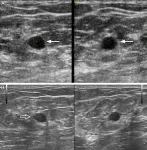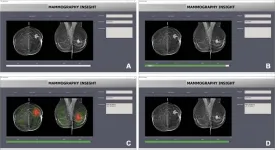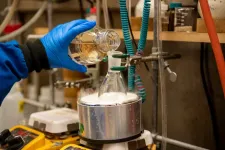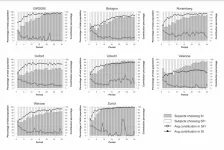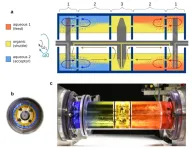(Press-News.org) States that provide stronger social safety nets have lower socioeconomic disparities in the brain development and mental health of children 9 to 11 years old, according to research supported by the National Institute on Drug Abuse (NIDA) at the National Institutes of Health. The disparity in brain structure between children from high- versus low-income households was more than a third lower in states with greater cash assistance than in those offering less, and the disparity in mental health symptoms was reduced by nearly a half.
The study, published in Nature Communications, highlights the impact that socioeconomic inequities can have on a child’s brain development, but demonstrates that this gap can be mitigated through state anti-poverty programs, such as Earned Income Tax Credit, Temporary Assistance for Needy Families, and Medicaid.
The findings reflect data from the large, multisite Adolescent Brain Cognitive Development Study (ABCD Study), led by NIDA. Researchers from Harvard University in Cambridge, Mass.; and Washington University, St. Louis, analyzed ABCD Study data from more than 10,000 youth across 17 states that differ in their cost of living and anti-poverty policies.
Emerging evidence has shown that children from families with lower income relative to children from families with higher income exhibit smaller hippocampal volume. The hippocampus plays a critical role in memory and emotional learning.
“Multiple studies have found associations between the brain changes shown in this research and meaningful impacts such as low test scores, lack of school readiness, and risk factors for mood disorders,” said NIDA Director Nora Volkow, M.D. “Investigating the policy factors that are associated with brain development and mental health is an important part of better understanding health inequities that impact people throughout their lives, starting in critical periods of development.”
Replicating findings from smaller studies, the research team first validated that lower family income is associated with smaller hippocampal volume and more symptoms of mental health conditions like anxiety, depression, aggression, impulsivity, and inattention among the 9-to 11-year-old participants. They expected these disparities among families with a high versus low income to be exacerbated in more expensive states, where the high cost of living places additional strain on low-income households.
As hypothesized, differences in hippocampal volume between children from high- and low-income families were greater in states with a higher cost of living. However, the availability and benefit value of monetary assistance programs in higher cost-of-living states reduced this disparity by 34%, and similarly, in states with Medicaid expansion, the disparity was reduced by 43%. Overall, more expensive cost-of-living states with anti-poverty programs in more expensive states had narrower gaps in income-associated differences in brain structure. Similar levels were observed in states with the lowest cost of living.
Additionally, the income-associated disparity in some mental health symptoms like anxiety and depression was 48% lower in expensive states with larger cash benefits than in states with lower cash benefits. These patterns remained significant when controlling for numerous state-level social, economic, and political characteristics, including population density, education equity, incarceration rates, and gender equity.
“The association between brain structure and a low-resource environment is not an inevitability,” said study author David Weissman, Ph.D., a postdoctoral fellow in the Stress and Development Lab at Harvard University. “Children’s brains are undergoing substantial development and have enhanced plasticity or capacity for further change based on their environment. These data suggest that policies and programs that work to reduce social and health inequities can directly reach children in disadvantaged environments and help support their mental health.”
Weissman and his team – which included Katie McLaughlin, Ph.D.; Mark Hatzenbuehler, Ph.D.; and Mina Cikara, Ph.D., at Harvard and Deanna Barch, Ph.D., at Washington University, St. Louis – also note that this is a correlational study, and there are many other factors for consideration to pinpoint exactly why disparities in brain development and mental health exist along different income levels. In future research, they hope to explore impacts of experimental cash-assistance interventions as well as other real-world policy changes to see how they relate to differences in mental health and brain structure in children.
The Adolescent Brain Cognitive Development Study and ABCD Study are registered service marks and trademarks, respectively, of the U.S. Department of Health and Human Services.
---------------------------------------------
For more information on substance and mental health treatment programs in your area, call the free and confidential National Helpline 1-800-662-HELP (4357) or visit www.FindTreatment.gov.
Reference: DG Weissman, et al. State-level macro-economic factors moderate the association of low income with brain structure and mental health in U.S. children. Nature Communications. DOI: 10.1038/s41467-023-37778-1 (2023).
###
About the National Institute on Drug Abuse (NIDA): NIDA is a component of the National Institutes of Health, U.S. Department of Health and Human Services. NIDA supports most of the world’s research on the health aspects of drug use and addiction. The Institute carries out a large variety of programs to inform policy, improve practice, and advance addiction science. For more information about NIDA and its programs, visit www.nida.nih.gov.
About the National Institutes of Health (NIH): NIH, the nation’s medical research agency, includes 27 Institutes and Centers and is a component of the U.S. Department of Health and Human Services. NIH is the primary federal agency conducting and supporting basic, clinical, and translational medical research, and is investigating the causes, treatments, and cures for both common and rare diseases. For more information about NIH and its programs, visit www.nih.gov.
About substance use disorders: Substance use disorders are chronic, treatable conditions from which people can recover. In 2021, over 46 million people in the United States had at least one substance use disorder. Substance use disorders are defined in part by continued use of substances despite negative consequences. They are also relapsing conditions, in which periods of abstinence (not using substances) can be followed by a return to use. Stigma can make individuals with substance use disorders less likely to seek treatment. Using preferred language can help accurately report on substance use and addiction. View NIDA’s online guide.
END
Scientists have developed two new drug candidates for potentially treating addiction and depression, modeled on the pharmacology of a traditional African psychedelic plant medicine called ibogaine. At very low doses, these new compounds were able to blunt symptoms of both conditions in mice.
The findings, published on May 2 in Cell, took inspiration from ibogaine’s impact on the serotonin transporter (SERT), which is also the target of SSRI antidepressants like fluoxetine (Prozac). A team of scientists from UCSF, Yale and Duke universities virtually screened 200 million molecular structures to find ones that blocked SERT in the same way ...
OAK BROOK, Ill. – Artificial intelligence (AI) can analyze breast mass images from low-cost portable ultrasound machines and accurately identify cancer, according to a study published in Radiology, a journal of the Radiological Society of North America (RSNA). This could prove useful for triage in low-resource settings.
Breast lumps are often found accidentally, during breast self-exam or during a breast exam by a medical professional. Breast cancer screening can find cancers in the breast before the lump can be felt.
While cancer screening has been the focus in Western countries, low- and middle-income ...
OAK BROOK, Ill. – Incorrect advice by an AI-based decision support system could seriously impair the performance of radiologists at every level of expertise when reading mammograms, according to a new study published in Radiology, a journal of the Radiological Society of North America (RSNA).
Often touted as a “second set of eyes” for radiologists, AI-based mammographic support systems are one of the most promising applications for AI in radiology. As the technology expands, there are concerns that it may make radiologists susceptible to automation bias—the tendency of humans ...
An AI model has been developed to automatically translate Akkadian text written in cuneiform into English. Hundreds of thousands of clay tablets from ancient Mesopotamia, written in cuneiform and dating back as far as 3,400 BCE, have been found by archeologists, far more than could easily be translated by the limited number of experts who can read them. Shai Gordin and colleagues present a new machine learning model that can automatically translate Akkadian cuneiform into English. Two versions of the model were trained. One version translates the Akkadian from representations of the cuneiform signs in Latin ...
A popular explanation for climate denialism is that humans will adopt beliefs that accord with their political orientation, using their cognitive abilities to explain away identity-inconsistent information in a process called “motivated reasoning.” To test this hypothesis, Bence Bago and colleagues challenged volunteers’ ability to think rationally using time pressure and cognitive loads of varying intensity. The team recruited American participants from Lucid, a website that connects academics with online survey participant pools. The authors found that people who had the ability to deliberate free of cognitive load or time ...
SAN ANTONIO – May 2, 2023 - Southwest Research Institute (SwRI) and The University of Texas at San Antonio (UTSA) have developed a method to synthesize the highly potent antimalarial drug artemisinin, which could lead to a more cost-effective treatment for malaria. The work, recently featured on the cover of the scientific journal Organic Letters, was supported by the Bill and Melinda Gates Foundation as well as a grant from the Connecting through Research Partnerships (Connect) program, a joint effort by SwRI and UTSA to enhance scientific collaboration between the two institutions.
In 2021, 247 million cases of malaria led to 619,000 deaths worldwide. The most effective ...
The American Society for Biochemistry and Molecular Biology sent recommendations to the National Institutes of Health on April 14 to improve working conditions for postdocs.
The society recommended that the NIH:
Ensure a livable wage, benefits, etc. for postdocs
Require that principle investigators help postdocs craft a training plan
Require that principal investigators complete mentor training programs
Expand programs to create more academic staff scientist positions
Collect data on postdoc career outcomes
“Many of our members who run labs are struggling to recruit and retain qualified postdocs,” Sarina Neote, public affairs director ...
A multi-lab replication of a 2006 study supports the role of peer sanction in promoting human cooperation. Cooperation is imperative for society to successfully solve complex problems, including climate change. One approach many groups have adopted is a system of peer sanctions for noncooperators. Such a system incurs costs to participants, who must impose the sanctions, but can allow cooperators to feel more secure that their investments in the shared project will be matched by others. A 2006 study suggested that groups with peer sanctions outgrew and outperformed groups without a peer-sanctioning institution. In light ...
In a world that is slowly distancing itself from carbon-based energy, there has been a meteoric rise in the use of lithium-ion batteries as a next-generation energy storage solution. However, this has resulted in another problem - an increase in the amount of lithium battery waste. Lithium-ion batteries degrade slowly over their lifetime, losing anywhere from 12% to 24% of their total capacity over 500 charging and discharging cycles. The electrolyte and other materials inside the battery can also degrade, causing a decrease in capacity over time. The disposal of lithium batteries ...
WASHINGTON, D.C. – The Patient-Centered Outcomes Research Institute (PCORI) today began inviting proposals for new studies and implementation projects through nine funding opportunities. These PCORI Funding Announcements (PFAs) include four offering up to $452 million for comparative clinical effectiveness research (CER) studies comparing health care approaches to help patients and their caregivers make better-informed health choices given their particular circumstances. Additional PFAs offer funding for a range of projects that support and advance patient-centered CER and use of PCORI-funded research results.
“With ...
